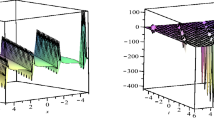Abstract.
A direct method, called the transformed rational function method, is used to construct more types of exact solutions of nonlinear partial differential equations by introducing new and more general rational functions. To illustrate the validity and advantages of the introduced general rational functions, the (3+1)-dimensional potential Yu–Toda–Sasa–Fukuyama (YTSF) equation is considered and new travelling wave solutions are obtained in a uniform way. Some of the obtained solutions, namely exponential function solutions, hyperbolic function solutions, trigonometric function solutions, Jacobi elliptic function solutions and rational solutions, contain an explicit linear function of the independent variables involved in the potential YTSF equation. It is shown that the transformed rational function method provides more powerful mathematical tool for solving nonlinear partial differential equations.
Similar content being viewed by others
References
M Malfliet, Am. J. Phys. 60, 650 (1992)
W X Ma and B Fuchssteiner, J. Non-Linear Mech. 31, 329 (1996)
Y Chen, B Li and H Q Zhang, Z. Angew. Math. Phys. 55, 983 (2004)
M L Wang, Phys. Lett. A213, 279 (1996)
C T Yan, Phys. Lett. A224, 77 (1996)
S K Liu et al, Phys. Lett. A289, 69 (2001)
Z Y Yan, Commun. Phys. Comput. 153, 1 (2003)
C Q Dai and J F Zhang, Chaos, Solitons and Fractals 27, 1042 (2006)
M L Wang and Y B Zhou, Phys. Lett. A318, 84 (2003)
M L Wang and X Z Li, Phys. Lett. A343, 48 (2005)
E Yomba, Phys. Lett. A340, 149 (2005)
Sirendaoreji and J Sun, Phys. Lett. A309, 387 (2003)
C P Liu and X P Liu, Phys. Lett. A348, 222 (2006)
S Zhang and T C **a, J. Phys. A: Math. Theor. 40, 227 (2007)
J H He and X H Wu, Chaos, Solitons and Fractals 30, 700 (2006)
S Zhang, Phys. Lett. A365, 448 (2007)
H Li and J L Zhang, Pramana – J. Phys. 72, 915 (2009)
W X Ma and J H Lee, Chaos, Solitons and Fractals 42, 1356 (2009)
T S Raju, C N Kumar and P K Panigrahi, J. Phys. A: Math. Gen. 38, L271 (2005)
V M Vyas et al, J. Phys. A: Math. Gen. 39, 9151 (2006)
A M Wazwaz, Appl. Math. Comput. 196, 363 (2008)
S J Yu et al, J. Phys. A: Math. Gen. 31, 3337 (1998)
J Schiff, Painlevé transendent, their asymptotics and physical applications (Plenum, New York, 1992)
A Boz and A Bekir, Comput. Math. Appl. 56, 1451 (2008)
Z Y Yan, Phys. Lett. A318, 78 (2003)
C L Bai and H Zhao, Phys. Lett. A354, 428 (2006)
H Zhao and C L Bai, Chaos, Solitons and Fractals 30, 217 (2006)
T X Zhang et al, Chaos, Solitons and Fractals 34, 1006 (2007)
A M Wazwaz, Appl. Math. Comput. 23, 592 (2008)
Z D Dai, F Liu and D L Li, Appl. Math. Comput. 207, 360 (2009)
X P Zeng, Z D Dai and D L Li, Chaos, Solitons and Fractals 42, 657 (2009)
Author information
Authors and Affiliations
Corresponding author
Rights and permissions
About this article
Cite this article
ZHANG, S., ZHANG, HQ. A transformed rational function method for (3+1)-dimensional potential Yu–Toda–Sasa–Fukuyama equation. Pramana - J Phys 76, 561–571 (2011). https://doi.org/10.1007/s12043-011-0068-5
Received:
Revised:
Accepted:
Published:
Issue Date:
DOI: https://doi.org/10.1007/s12043-011-0068-5




